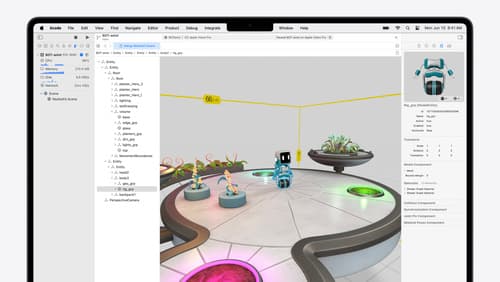what is folder structure for Xcode framework
Asked on 2024-08-01
1 search
The folder structure for an Xcode framework project can be organized in various ways depending on the specific needs of the project. Here are some insights from the WWDC sessions that can help you understand how to structure your Xcode project:
-
Project Layout and Folders:
- In the session Port advanced games to Apple platforms, it is mentioned that the project layout organizes documents into folders, each providing concrete information on how to port your game subsystems like graphics, shaders, audio, game controllers, and more. Each folder contains a lesson with all associated code, making it easy to focus on specific parts of the project.
-
Navigators and File Hierarchy:
- The session Xcode essentials discusses the use of the Project Navigator to show the project's file hierarchy. It suggests adding folders to organize files better and using specialized filters to manage the files effectively.
-
Target-Specific Files:
- In the session Port advanced games to Apple platforms, it is explained that Xcode allows you to differentiate elements like libraries, frameworks, and parts of code depending on the target (e.g., macOS or iOS). You can use filters to specify files for a specific target based on the SDK, which helps in managing shared files and target-specific files.
-
Debugging and Testing:
- The session Break into the RealityKit debugger shows how to use the debug navigator to explore captured RealityKit scenes, which can be part of your project structure if you are working with 3D content.
-
Distribution and Archiving:
- The session Xcode essentials covers how to distribute your app by repackaging the contents for different destinations. This involves using the product menu to archive your app and then distribute it via TestFlight or the App Store.
In summary, organizing your Xcode project into well-defined folders for different subsystems, using navigators and filters to manage files, and setting up target-specific files are key aspects of structuring your Xcode framework project.

Break into the RealityKit debugger
Meet the RealityKit debugger and discover how this new tool lets you inspect the entity hierarchy of spatial apps, debug rogue transformations, find missing entities, and detect which parts of your code are causing problems for your systems.

Xcode essentials
Edit, debug, commit, repeat. Explore the suite of tools in Xcode that help you iterate quickly when developing apps. Discover tips and tricks to help optimize and boost your development workflow.

Port advanced games to Apple platforms
Discover how simple it can be to reach players on Apple platforms worldwide. We’ll show you how to evaluate your Windows executable on Apple silicon, start your game port with code samples, convert your shader code to Metal, and bring your game to Mac, iPhone, and iPad. Explore enhanced Metal tools that understand HLSL shaders to validate, debug, and profile your ported shaders on Metal.
